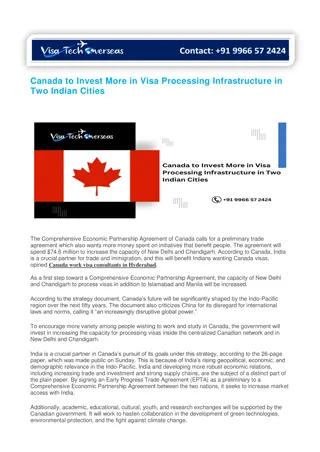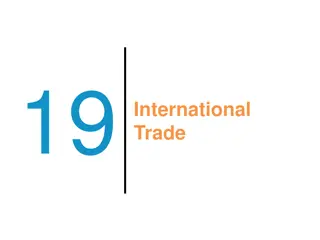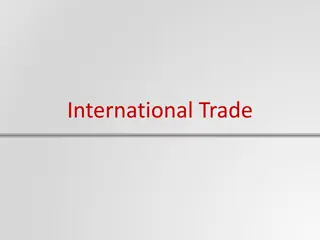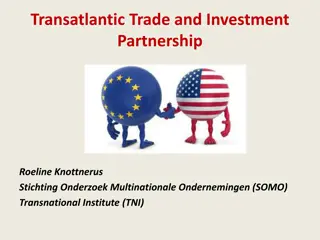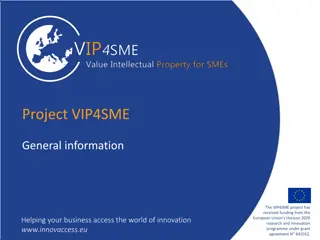Lessons from Lilly v. Canada: Intersections of Trade, Investment, and Intellectual Property
Lilly v. Canada case examines the intersection between trade, investment, and intellectual property rights, focusing on patent issues related to Zyprexa and Strattera. It discusses NAFTA Chapter 11, Investor-State Dispute Settlement, and implications for India in trade agreements. The case raises concerns about the Promise Doctrine and potential redefinition of legal terms under international treaties.
Download Presentation

Please find below an Image/Link to download the presentation.
The content on the website is provided AS IS for your information and personal use only. It may not be sold, licensed, or shared on other websites without obtaining consent from the author.If you encounter any issues during the download, it is possible that the publisher has removed the file from their server.
You are allowed to download the files provided on this website for personal or commercial use, subject to the condition that they are used lawfully. All files are the property of their respective owners.
The content on the website is provided AS IS for your information and personal use only. It may not be sold, licensed, or shared on other websites without obtaining consent from the author.
E N D
Presentation Transcript
New Intersections between Trade, Investment and Intellectual Property: Lessons from Lilly v Canada Professor Daniel Gervais Professor Daniel Gervais
Disclaimer Approached by both sides Retained by Canada vs 2
Background Patents issued on Zyprexa and Strattera (atomoxetine and olanzapine) Invalidated by Federal Court of Appeal (FCA); leave to appeal to Supreme Court of Canada refused FCA uses promise of the patent doctrine As part of its utility analysis Lilly argues indirect expropriation and lack of Fair and Equitable Treatment (FET) under NAFTA Chapter 11 3
NAFTA North American Free Trade Agreement Canada, Mexico, US 1993 Substantive IP provisions similar to TRIPS Without Articles 7 and 8 4
What is NAFTA Chapter 11? Investor-State Dispute Settlement (ISDS) Creates special investment-focused dispute-settlement mechanism with ad hoc arbitral tribunals Unlike WTO, no appeal Potential role of factors other than alleged lost investment not clear No general exception , right to regulate, etc. 6
Why is this relevant for India? ISDS is almost all pending trade agreements TPP RCEP And hundreds of BITs and FTAs 7
RCEP & India Proposals tabled by Korea and Japan Similar to TPP text India and China prefer different proposals The Indian government currently considering revised model draft bilateral investment treaty that reduces investor rights 8
The Promise doctrine: Lilly s view (continued) Lilly: new, radically different standard for determining whether inventions fulfill [utility] requirement If Canada can unilaterally reinterpret a core legal term in such a stark manner and with such severe consequences, legally operative words in NAFTA with internationally-accepted meanings could be susceptible to unilateral re-definition, such that NAFTA will no longer establish foundational requirements for patent protection 10
In other words Lilly trying to use the notions of indirect expropriation and FET in the investment chapter of NAFTA to challenge the invalidation of two patents by Canadian courts, where Lilly unquestionably received fair tratemtn and due process 11
Why not State-to-State? [Investor-state arbitration] does not apply to the issuance of compulsory licenses granted in relation to intellectual property rights, or to the revocation, limitation or creation of intellectual property rights, to the extent that such issuance, revocation, limitation or creation is consistent with Chapter Seventeen(Intellectual Property). - NAFTA 1110(7) 13
How Far Could This Go? Lilly relied on Canada s patent law when it sought patent protection for Zyprexa and Strattera and launched those drugs in Canada ; patents had been issued after a careful review by Canada s patent examiners in light of Canada s utility. Can be rephrased as arguing that any invalidation by a court of an issued patent would amount to expropriation 14
Fair & Equitable Treatment Lilly also makes a case of legitimate expectation by investor that patentability criteria will not change as part of its FET claims Basically, MNCs expect no change in regulatory structure they view as negative or radical Or compensation for any such change An international efficient breach doctrine 15
Canadas Response Time-bar No legitimate expectation under FET Lilly received FET Patentability criteria change and are reinterpreted by courts E.g. is US: Alice, KSR etc. US utility criterion plays different policy role No enablement or written description test in Canadian law 16
The new promise doctrine? Quote from 1981 SCC case There is a helpful discussion in Halsbury s Laws of England on the meaning of not useful in patent law. It means that the invention will not work, either in the sense that it will not operate at all or, more broadly, that it will not do what the specification promises that it will do . [ ] The discussion in Halsbury s Laws of England [ ] continues: [T]the practical usefulness of the invention does not matter, nor does its commercial utility, unless the specification promises commercial utility, nor does it matter whether the invention is of any real benefit to the public, or particularly suitable for the purposes suggested. Canadian law is to the same effect. Consolboard Inc. v. MacMillan Bloedel (Sask.) Ltd., [1981] 1 S.C.R. 504, 525
1128 Mexico and the United States basically support Canada s position on indirect expropriation and FET 22
Right to regulate Close to notion of police powers in public international law Philip Morris v Uruguay (July 2016): Interference with foreign property in the valid exercise of police power is not considered expropriation and does not give rise to compensation 23
Police power Saluka v Czech Republic (2006) It is now established in international law that States are not liable to pay compensation to a foreign investor when, in the normal exercise of their regulatory powers, they adopt in a non- discriminatory manner bona fide regulations that are aimed to the general welfare. 24
Regulatory flexibility Notion of indirect expropriation used by a private non-state actor to challenge Canada s sovereign/ unilateral ability to regulate its substantive patent law and public health policy 25
State-to-State v ISDS No general exception in ISDS like GATT XX and GATS XIV No sector-specific right to regulate exception No specific exception like TRIPS 31 or 31bis( paragraph 6 system) Basically: Little room for the consideration of the public interest in a regime so heavily weighted towards investor protection. (Kate Miles) 27
Normative Battles WTO: trade, yes, but not in clinical isolation from international law e.g. FCTC will be used to give Australia a win in the pending WTO dispute Expropriation s lodestar is property Are pharmaceutical patents just like any other property ? A patent right, if it is property at all, also has a social purpose Patents create incentives in the (private) interest of the patent holder But for the greater public interest in access to innovation
Options to ameliorate the framework 1. Constitutional approach of international law Free trade as human right Risky: takeover / hierarchical normative framework 2. Contract-based theories Stipulation pour autrui (stipulation for another) Efficient breach? 3. General balancing approach 4. Vienna Convention (VCLT) Strong doctrinal basis Object and purpose in art 31(1) includes both an immediate and a broader context 31
ISDS and privity of contract Can there be an obligation for beneficiary accepting the benefit contained in a contract entered into by others? Stipulation for another 32
What we need to move forward: Strong policy positions Nor will the Government support provisions [in ISDS] that would constrain the ability of Australian governments to make laws on social, environmental and economic matters circumstances where those laws do not discriminate between domestic and foreign businesses. (Australia gvt) 34
My Suggestions Build express interfaces Narrowly tailor ISDS (Ruth Okediji, 2014) Exclude substantive IP rules from ISDS, as EU has done in both CETA and TTIP Include explicit safeguards for labor, environment and sustainable development often explicitly demand a high level of protection and put these interests above that of liberalization of trade (EU position) Safeguards should preserve a right to regulate 36
Vienna Plus: An InterpretationDoctrine for ISDS Proposed rule: An ISDS tribunal ought not to interpret a provision in an FTA or BIT if another interpretation that allows a state to comply with its human rights obligations is possible. Jettisons or sidesteps the necessity and least restrictive tests of trade law Vienna-plus approach : Establish an ISDS supplement to Vienna Add to statute of a permanent ISDS tribunal (as in European proposal) 37
Indias Role India could take the lead in reforming ISDS by implementing a new model 38



